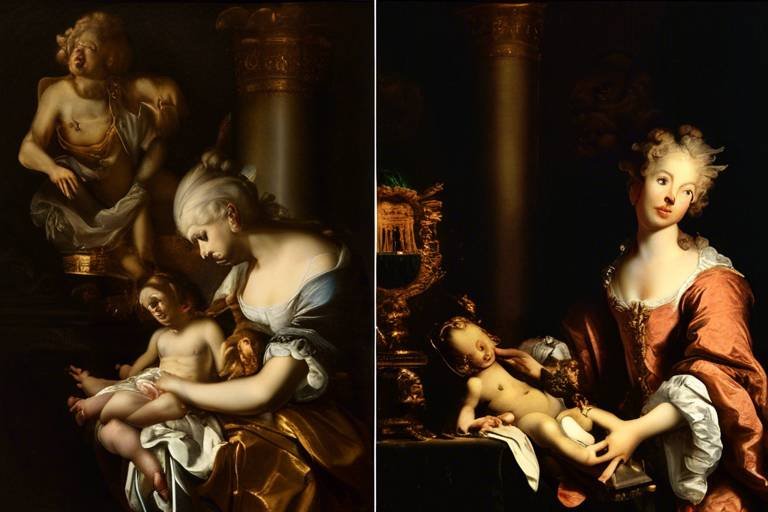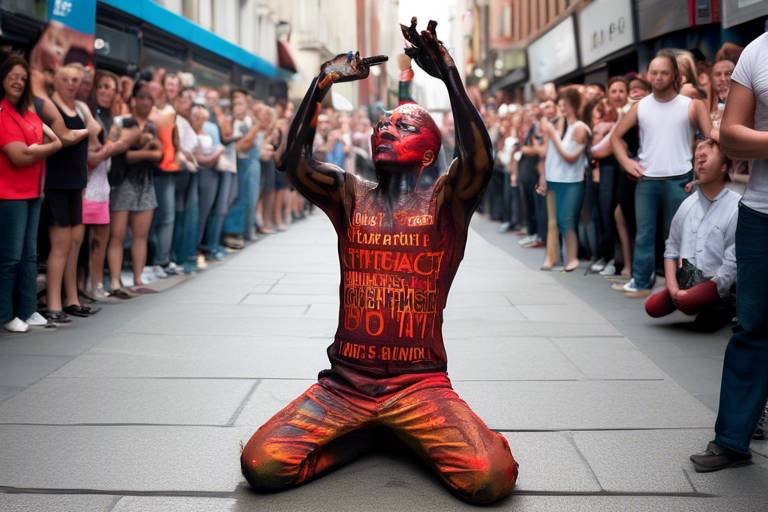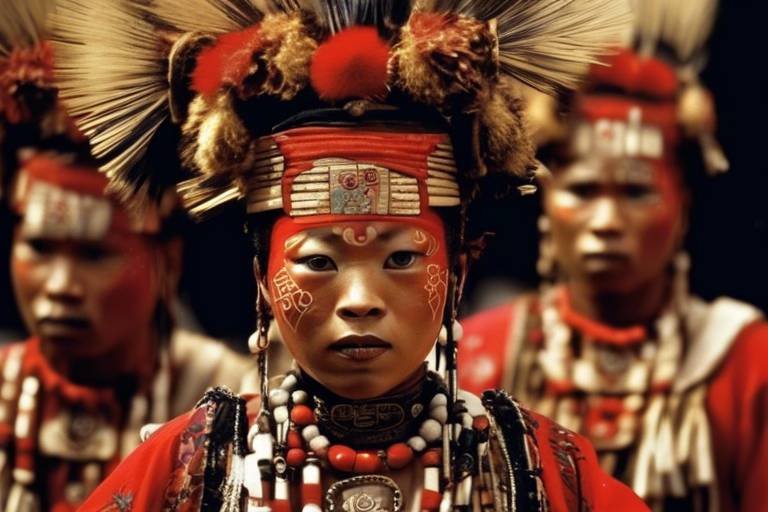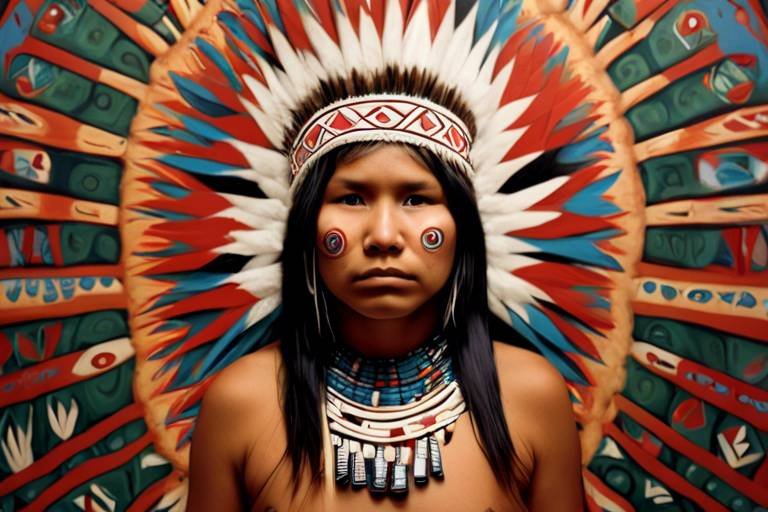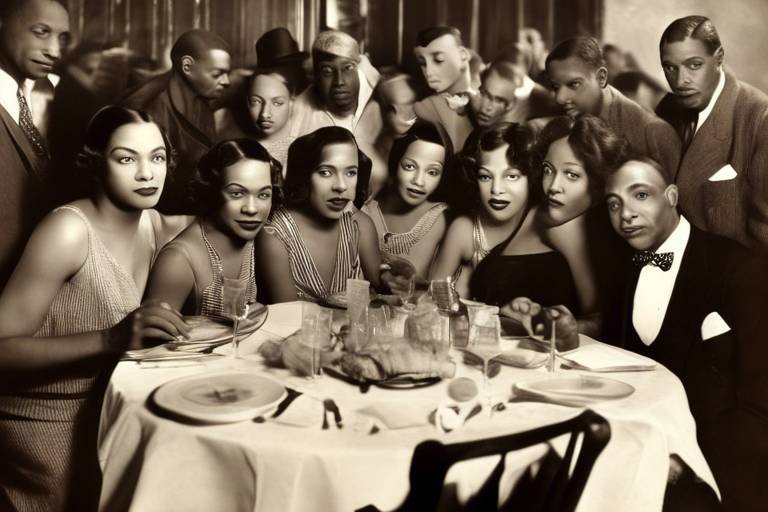The Use of Light in Baroque Art
Baroque art is renowned for its dramatic use of light, a key element that revolutionized the way artists conveyed emotion and narrative in their works. During the Baroque period, artists skillfully manipulated light to create striking contrasts between light and shadow, known as chiaroscuro, to evoke powerful emotions and captivate viewers. This innovative approach to lighting not only added depth and dimension to artworks but also infused them with a sense of theatricality and dynamism.
One of the most prominent figures in Baroque art, Caravaggio, mastered the technique of chiaroscuro, using bold contrasts of light and dark to achieve a heightened sense of drama in his paintings. His innovative use of light not only illuminated his subjects but also added a sense of mystery and intensity, drawing viewers into the narrative of the artwork.
Light in Baroque art was not merely a visual element but also carried symbolic significance. In religious paintings, light was often used to symbolize divine presence, spiritual enlightenment, and the transcendent nature of the subject matter. Through the strategic placement of light sources and the manipulation of shadows, artists conveyed a sense of the divine and imbued their works with a sense of awe and reverence.
Moreover, the interplay of light and shadow in Baroque art was instrumental in creating emotional impact and engaging the viewer on a visceral level. By carefully orchestrating the distribution of light, artists were able to evoke a wide range of emotions, from joy and exultation to sorrow and despair, effectively enhancing the storytelling aspect of their works.
Architects and sculptors in the Baroque period also utilized light to great effect, integrating it into their designs to create dynamic spatial effects and enhance the three-dimensional quality of their works. Light played a crucial role in defining the form and structure of Baroque buildings and sculptures, adding a sense of grandeur and magnificence to their creations.
Light was not just a visual element in Baroque art but also served as a narrative device, guiding the viewer's gaze, highlighting key elements in a composition, and creating a sense of movement and drama. Artists employed various techniques, such as sfumato, tenebrism, and spotlighting, to achieve dramatic lighting effects that enhanced the overall impact and visual appeal of their artworks.

Caravaggio's Mastery of Chiaroscuro
Caravaggio, the renowned Baroque artist, is celebrated for his exceptional mastery of chiaroscuro. This technique, characterized by stark contrasts between light and dark, allowed Caravaggio to create mesmerizing depth and drama in his paintings. By skillfully manipulating light and shadow, he was able to infuse his works with a sense of theatricality and intensity that captivated viewers.

Symbolism of Light in Baroque Art
Exploring the significance of light in Baroque art, how artists utilized light to create drama and emotion, and the techniques employed to achieve the dramatic effects characteristic of the Baroque period.
Examining Caravaggio's innovative use of chiaroscuro, a technique involving strong contrasts between light and dark, to create a sense of depth and drama in his paintings.
In Baroque art, light was not merely a tool for illuminating scenes but also carried symbolic significance, representing divine presence, spiritual enlightenment, and conveying dramatic narratives in both religious and secular subjects. Artists of the Baroque period employed light symbolically to evoke deeper meanings and emotional responses in viewers.
Baroque artists often depicted divine illumination in religious paintings through the use of radiant light sources, halo effects, and celestial lighting. This symbolic use of light aimed to convey the presence of the divine, creating a sense of awe and spirituality in the viewer.
The interplay of light and shadow in Baroque art was a powerful tool for eliciting strong emotional responses in viewers. By skillfully manipulating light and shadow, artists were able to enhance the dramatic storytelling of their works, creating a heightened sense of tension, mystery, and emotion.
Baroque architects integrated light sources, both natural and artificial, into their designs to achieve dynamic spatial effects and enhance the grandeur of their buildings. Light played a crucial role in highlighting architectural elements, creating a sense of movement, and evoking a dramatic atmosphere within the space.
Sculptors in the Baroque period utilized light and shadow to enhance the three-dimensional quality of their works. By strategically placing light sources, sculptors were able to create dynamic and lifelike figures that appeared to come alive in the play of light and shadow.
Baroque artists skillfully used light as a narrative device to guide the viewer's gaze, emphasize key elements in a composition, and create a sense of movement and drama within their artworks. Light was not just a visual element but a storytelling tool that added depth and meaning to the narrative.
Baroque artists employed various techniques such as sfumato, tenebrism, and spotlighting to create striking and theatrical lighting effects in their artworks. These techniques allowed artists to manipulate light and shadow to evoke specific moods, enhance the dramatic impact of their compositions, and captivate the viewer's attention.

Divine Illumination in Religious Art
In Baroque religious art, the concept of divine illumination played a crucial role in conveying the spiritual essence of the subjects depicted. Artists sought to represent the presence of the divine through the use of radiant light sources, halo effects, and celestial lighting. By illuminating figures or scenes with a heavenly glow, they aimed to evoke a sense of awe and reverence in the viewer, emphasizing the sacred nature of the subject matter.
One of the key techniques employed to achieve divine illumination was the strategic placement of light sources to create a sense of transcendence and holiness. Figures bathed in ethereal light were often portrayed with a sense of serenity and grace, symbolizing their connection to the divine realm. This use of light not only added a mystical quality to the artworks but also served to guide the viewer's focus towards the spiritual significance of the composition.
Furthermore, the symbolic representation of light in religious art was not merely a visual element but a narrative device that conveyed deeper meanings and theological concepts. The contrast between light and shadow was used to symbolize the eternal struggle between good and evil, with light representing purity, enlightenment, and divine grace, while darkness symbolized sin, ignorance, and spiritual darkness.
Through the manipulation of light and shadow, Baroque artists were able to create a sense of drama and intensity in their religious works, heightening the emotional impact on the viewer and reinforcing the spiritual themes depicted. The interplay of light and dark not only added visual interest but also imbued the artworks with a sense of dynamic movement and energy, drawing the viewer into the sacred narrative unfolding before them.

Emotional Impact through Light and Shadow
Emotional Impact through Light and Shadow in Baroque art is a powerful tool that artists utilized to evoke intense feelings and captivate viewers. The contrast between light and shadow was skillfully employed to create dynamic compositions that stirred emotions and heightened the dramatic storytelling within artworks. By strategically placing light sources and casting shadows, Baroque artists were able to enhance the mood and atmosphere of their paintings, drawing the viewer into the narrative with a sense of immediacy and intensity.

Architectural Effects of Light in Baroque Art
Architectural effects of light in Baroque art played a crucial role in shaping the grandeur and drama of the period's architectural masterpieces. Baroque architects skillfully utilized light as a tool to enhance the spatial experience within their buildings, creating dynamic and immersive environments that captivated visitors. The interplay of natural and artificial light sources was carefully orchestrated to highlight architectural details, create dramatic contrasts, and evoke a sense of awe and splendor.
One of the key techniques employed by Baroque architects was the use of large windows and openings to allow natural light to flood into interior spaces. This not only illuminated the intricate ornamentation and decorative elements of the buildings but also created a sense of movement and vitality within the architecture itself. The play of light and shadow on surfaces and textures added depth and dimension, transforming static structures into dynamic and visually engaging spaces.
In addition to natural light, Baroque architects also incorporated artificial lighting elements such as candles, chandeliers, and lanterns to further enhance the visual impact of their designs. These artificial light sources were strategically placed to create focal points, highlight important architectural features, and draw the viewer's eye towards key elements of the space.
The use of light in Baroque architecture was not merely functional but also symbolic, with light often representing divine presence and spiritual enlightenment. The dramatic lighting effects created by Baroque architects were intended to evoke an emotional response in viewers, immersing them in a heightened sensory experience that transcended the physical boundaries of the built environment.

Baroque Sculpture and Light
Baroque sculpture, much like painting and architecture of the period, embraced the dramatic interplay of light and shadow to create dynamic and lifelike figures. Sculptors skillfully utilized light to enhance the three-dimensional quality of their works, imbuing their sculptures with a sense of movement and vitality. The use of light and shadow in Baroque sculpture was not merely about illumination but rather a deliberate technique to sculpt emotions and narratives in stone or bronze.
One of the key techniques employed by Baroque sculptors was the manipulation of light to carve out intricate details and create depth within the sculpted forms. By strategically placing light sources, sculptors could highlight specific features, contours, and textures, adding a sense of realism and dynamism to their creations. The careful consideration of light and shadow allowed sculptors to evoke different moods and emotions, transforming static figures into dynamic compositions that engaged the viewer's imagination.
Baroque sculptors also utilized the contrast between light and shadow to accentuate the dramatic elements of their works. By casting shadows in strategic areas and illuminating specific parts of the sculpture, artists could create a sense of tension, movement, and theatricality. This play of light not only enhanced the visual impact of the sculptures but also contributed to the overall narrative and storytelling, inviting viewers to interact with the artwork on a deeper level.
Moreover, the use of light in Baroque sculpture was instrumental in creating a sense of realism and naturalism. Sculptors paid close attention to how light interacted with the surfaces of their works, carefully sculpting forms to capture the effects of light and shadow realistically. This attention to detail and mastery of light allowed Baroque sculptors to achieve a level of naturalism that brought their sculptures to life, blurring the line between art and reality.

Light as a Narrative Device
Light in Baroque art serves as a powerful narrative device, guiding the viewer's gaze and emphasizing key elements within a composition. Just as a spotlight on a stage directs the audience's attention to a particular actor, light in Baroque paintings illuminates crucial figures or objects, drawing the viewer into the story being told. It creates a sense of movement and drama, enhancing the overall impact of the artwork.
Baroque artists strategically manipulated light to convey specific emotions and narratives. By illuminating a central figure or a pivotal moment in a scene, they were able to evoke a range of feelings in the viewer, from awe and reverence to suspense and excitement. The interplay of light and shadow not only added visual interest but also deepened the storytelling aspect of the artwork, making it more engaging and immersive.
In some Baroque paintings, light is used to symbolize divine presence or spiritual enlightenment. Just as a beacon of light in the darkness signifies hope or guidance, the use of radiant light sources in religious art conveys a sense of transcendence and the divine. By infusing their works with symbolic light, artists were able to elevate the spiritual themes of their paintings and evoke a sense of awe in the viewer.
Furthermore, light in Baroque art is not merely a passive element but an active participant in the narrative. It can create contrasts between characters or highlight significant moments in a story. By playing with light and shadow, artists could manipulate the mood and atmosphere of a scene, intensifying the emotional impact on the viewer and enhancing the overall storytelling experience.

Techniques for Achieving Dramatic Lighting Effects
Baroque artists were masters of creating dramatic lighting effects in their artworks, utilizing various techniques to achieve stunning visual impact. One of the key methods employed by Baroque painters was sfumato, a technique that involved the gradual blending of colors and tones to create soft transitions between light and shadow. This technique allowed artists to achieve a sense of depth and atmospheric perspective in their compositions, enhancing the overall dramatic effect.
Another prominent technique used by Baroque artists was tenebrism, characterized by stark contrasts between light and dark areas in a painting. By emphasizing extreme chiaroscuro effects, tenebrism heightened the sense of drama and tension in the artwork, creating a powerful visual impact that captivated viewers. This technique was often employed in religious and mythological scenes to evoke strong emotional responses and highlight key elements of the composition.
In addition to sfumato and tenebrism, Baroque artists also utilized spotlighting as a technique to draw attention to specific areas of a painting. By focusing a strong light source on particular figures or objects within the composition, artists could create a sense of theatricality and intensity, guiding the viewer's gaze and enhancing the narrative impact of the artwork. This technique was particularly effective in creating dynamic and engaging visual narratives that captured the viewer's imagination.
Frequently Asked Questions
- What is the significance of light in Baroque art?
The use of light in Baroque art was crucial for creating drama, emotion, and depth in artworks. Artists utilized light to evoke strong emotional responses in viewers and enhance the storytelling of their compositions.
- How did Caravaggio use chiaroscuro in his paintings?
Caravaggio mastered chiaroscuro, a technique involving strong contrasts between light and dark, to create a sense of depth and drama in his artworks. This technique added a dynamic and theatrical quality to his paintings.
- Why was light used symbolically in Baroque art?
Light in Baroque art was used symbolically to represent divine presence, spiritual enlightenment, and to convey dramatic narratives in both religious and secular subjects. It added layers of meaning and symbolism to the artworks.
- How did Baroque architects use light in their designs?
Baroque architects integrated natural and artificial light sources in their designs to create dynamic spatial effects and enhance the grandeur of their buildings. Light played a crucial role in shaping the architectural experience.
- What techniques did Baroque artists use to achieve dramatic lighting effects?
Baroque artists employed techniques such as sfumato, tenebrism, and spotlighting to create striking and theatrical lighting effects in their artworks. These techniques added depth and intensity to their compositions.

